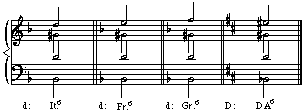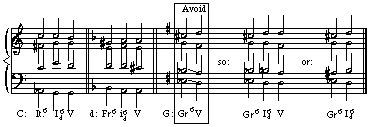
(read also: Turek, vol. 2, pp. 64-74)
Augmented sixth chords (there are 4 basic types) are simply S-type chords. They all function as predominants, similar to ii, IV, and N6. The name has nothing to do with the inversion of the chord, it comes from the characteristic interval found in each type.
Spelling:
Italian +6 (It6) b6 1 #4
French +6 (Fr6) b6 1 2 #4
German +6 (Gr6) b6 1 b3 #4
Doubly Augmented Sixth (DA6) b6 1 #2 #4

Note that all four types include scale degrees b6, 1, and #4. In minor, b6 is diatonic but in major, the diatonic sixth scale degree must be lowered one half step. It is possible that these chords will include both flats and sharps in them. The different types result from the inclusion of one additional scale degree as indicated in the chart above. The German +6 chord includes b3, in minor, this is the diatonic scale degree three, in major, scale degree three must be lowered one half step. The Gr6 and DA6 chords both sound just like a dominant seventh (Mm7) chord, but are not spelled and do not function in that manner.
The normal position for these chords is to have b6 in the bass voice. They may occur in other "inversions", but not very often.
Doubling:
For the It6 chord, double the tonic (1) scale degree. Since the other types all include four different notes, none of them will be doubled. Under no circumstances should you double b6 or #4.
Voice Leading: The augmented sixth interval (b6-#4) must resolve out to an octave using contrary motion. It needs to resolve in this fashion because b6 is an upper leading tone to 5, while #4 is a lower leading tone to 5. The other voices resolve by step (where possible) to the nearest tone of the chord of resolution. The Fr6 and It6 may resolve to either I64 or V(7). The Gr6 will usually resolve to a I64 because a smooth resolution directly to V produces parallel fifths. The DA6 resolves only to I64 and is used only in major. It sounds identical to the Gr6 but the spelling is slightly different for the purpose of smoother voice leading.

A typical progression would be: i V6 V42/iv IV6 +6 (any type) i64 V(7) i

click the example to hear.
